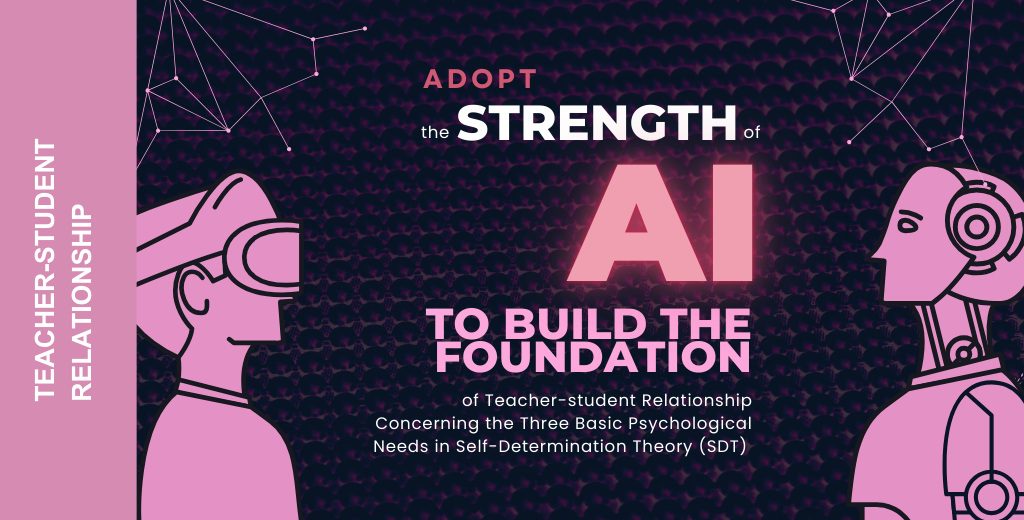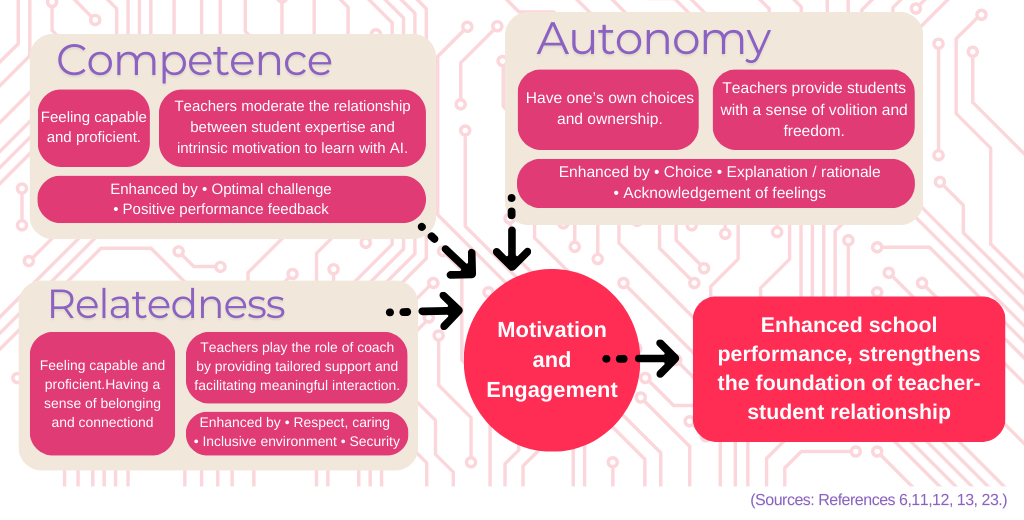
2024 December Issue
Adopt the Strength of AI to Build the Foundation of Teacher-student Relationship Concerning the Three Basic Psychological Needs in Self-Determination Theory (SDT)
Artificial Intelligence (AI) is getting into classrooms too fast for us to keep pace1. It has completely changed what we know about teaching, learning and educational technologies in higher education2. Concerning Self-Determination Theory (SDT), this article will briefly explore the potential impact on the teacher-student relationship brought about by using AI and also suggest the role of teachers and their attitude towards using AI. It may be helpful to teachers who are considering implementing AI in their courses.
Self-Determination Theory (SDT) is a framework for understanding human motivation that emphasizes the importance of intrinsic and extrinsic motivations, as well as the fulfilment of basic psychological needs of autonomy, competency and relatedness3,4. Using AI, students can get tailored learning materials such as foundational exercises and explanations for students who need extra help and more advanced content and questions for students who are already proficient5. The easy access to information and resources develops their self-learning skills5 and gives them freedom in learning. Autonomy refers to the feeling of having their own choices and ownership6. Autonomy support happens when teachers provide students with a sense of volition and freedom that helps students develop their inner motivation7. Using AI in education can help fulfil the need of autonomy. And there is a positive correlation between need-supportive teaching and the teacher-student relationship8.
The use of AI can also enhance the sense of competence9. Having the feeling of capable and proficient satisfied the need of competency6. Students who use AI to learn would feel more capable in the learning processes when received the tailored feedback and resources provided by AI9. Most studies on behavioural intention to use technology show that competency is crucial in motivating students to learn with AI6. However, the involvement of teachers may be different to students of varying levels. Novice students preferred to receive teacher support when learning with AI, while advanced students had greater intrinsic motivation without teachers’ presence6. Teachers should play a moderating role in the relationships between student expertise and intrinsic motivation to learn with AI and should take note of the importance of carefully designing the learning task with chatbots involving so as to support student competence6. Students who feel autonomous and competent are more likely to engage positively with their teachers6,8.
Students direct their own learning with the help of AI, while teachers could afford the opportunity to evolve their role from direct instruction to the role of coach5,10. This allows the provision of tailored support to specific students and creates opportunities for meaningful interaction11,12. Teacher-student relationships encompass emotional bonds and interpersonal connections8. When students have a sense of belonging and connection, the need of relatedness is fulfilled13. Teachers’ support was the influential factor of relatedness6. Students may feel more connected to the learning due to stronger teacher-student relationships6. For some students, teachers’ physically participating in activities and giving students more pointers and feedback show teachers’ care and involvement, thereby supporting students’ need for relatedness14. It is evident that students’ feeling of relatedness is positively influence their emotional state, school satisfaction, and overall well-being8.

There are concerns of AI endangers teaching behaviour, expression and creates threat for those teachers who are unable to provide targeted support to specific students because they are unable to understand the students in-depth11 on a personal level14. The lack of in-depth understanding arouses the trust issue15.
The launch of AI greatly reduces the time and increases the accuracy of searching for suitable information. For those who misuse it, AI could massively reduce the cost and effort required to engage in cheating15. This has conditioned people to associate AI with cheating1. Students reflected that people are too focused on the bad side of using AI15. This perception raised their concern about being misunderstood as not independent, not paying effort with poor language skills and then being put at a disadvantage15. They are unsure if teachers would trust that they won’t cheat after seeking help from AI15. Trust is one of the most significant factors contributing to a healthy, positive, and mutually beneficial teacher-student relationship15. The concern of being wrongly accused of AI cheating creates barriers to open communication, sparks fear and drives distrust between students and teachers15.
When adopting AI tools in teaching, teachers should be cautious of their accuracy and reliability and bear the responsibility of using the educational resources obtained through these tools16. There are 4 possible approaches, which include i) prohibit all use of AI tools (by default), ii) use only with prior permission, iii) use only with explicit acknowledgement and iv) use is freely permitted with no acknowledgement16. Please refer to Guidelines on the Use of Artificial Intelligence Tools in Teaching, Learning and Assessment (CUHK staff login required) for details. CLEAR supports teachers in the use of AI, we have prepared an AI resource poster introducing the basics of AI and the five big ideas in AI. Please check it here.
Teachers may consider using AI to get academic support and mental support. Julian™, an AI-powered tutor, built with Google Cloud’s AI and machine learning (ML) capabilities, driving personalized experiences and knowledge mastery through various educational engagement activities17. Teachers load the course learning content into the tool’s platform and specify the required knowledge in the form of learning units17. Students could master concepts through on-demand learning activities. This technology engages students in dialogue via chat functionality, offers learning activities, evaluates student responses, and provides feedback to students17. In this example, AI is used as a facilitator, which refers to the condition that students can collaborate with AI technologies for self-learning6. AI-powered teachers by offering academic support to students, teachers then can address complex queries and provide emotional and psychological support18 to students.
Mental health is a crucial aspect of overall wellness, and teachers often face high levels of stress and burnout19. There is a positive correlation between teacher trait mindfulness and the quality of teacher-student relationships20. It is not difficult to find AI function in chatbots, like TourHeart+. It is an evidence-based one-stop online stepped-care platform combining an online self-help mental support platform with in-person counselling service21. Teachers can explore their emotions and life challenges through conversations with a chatbot, Boon22. TourHeart+ also provides self-assessment, online courses, emotions monitoring tools and workshops21. Through mindfulness practices, teachers develop the capacity to be fully present and attentive in their interactions with students, leading to more profound connections and a heightened capacity for empathetic understanding20, thus a potential positive teacher-student relationship.
AI changed teaching and learning and the dynamic of the teacher-student relationship. It can provide a wide range of tailored learning materials, fostering student autonomy and engagement, which enables teachers to shift their role from direct instruction to coaching. Teachers could focus on developing more meaningful interactions with students to strengthen their connection with students and perceive themselves as playing a moderating role in the relationships between student expertise and intrinsic motivation to learn with AI. AI can generate text and simulate some forms of reasoning but not every time very well10 and it cannot coach without a human coach training and guidance. Overreliance on it could even weaken human interaction. AI’s capability in personalised teaching not only enhance instructional effectiveness but also strengthens the foundation of teacher-student relationships. It is important for teachers to note that they need to move away from assessment and towards coaching because this cannot be performed by AI1.
- Smith, E. St. C. (2024). How AI Can Help Teachers Guide Students to Active Learning. https://www.edutopia.org/article/ai-teacher-student-relationships/
- Lodge, J. M., Thompson, K. and Corrin, L. (2022). The concerning persistence of weird ideas about learning and educational technology and their influence on the future directions of higher education. Australasian Journal of Educational Technology, 38(3), 1-5. https://doi.org/10.14742/ajet.8226
- Ryan, R.M., & Deci, E.L. (2000). Self-determination theory and the facilitation of intrinsic motivation, social development, and well-being. American Psychologist, 55(1), 68-78. https://doi.org/10.1037/0003-066X.55.1.68
- Deci, E.L., & Ryan, R.M. (2000). The “what” and “why” of goal pursuits: Human needs and the self-determination of behavior. Psychological Inquiry. 11(4), 227–268. https://doi.org/10.1207/S15327965PLI1104_01
- Ma, C., Lan, T., Xue, H., Xu, L., Wang, C. and Hong, Z. (2024). Reshaping the teacher-student relationship in higher education through ChatGPT. Journal of Education and Education Research. 10(1) ,297-300. https://doi.org/10.54097/sqszfv73
- Chiu, T. K. F., Moorhouse, B. L., Chai, C. S. and Ismailov, M. (2024). Teacher support and student motivation to learn with Artificial Intelligence (AI) based chatbot. Interactive Learning Environments. 32(7), 3240-3256. https://doi.org/10.1080/10494820.2023.2172044
- King, R. B., Haw, J. Y. and Wang, Y. (2024). Need-support facilitates well-being across cultural, economic, and political contexts: A self-determination theory perspective. Learning and Instruction, 93: 101978. https://doi.org/10.1016/j.learninstruc.2024.101978
- Wu, D. and Dong, X. (2024). Autonomy support, peer relations, and teacher-student interactions: implications for psychological well-being in language learning. Frontiers in Psychology, 15:1358776, https://doi.org/10.3389/fpsyg.2024.1358776
- Weng, X., Xia, Q., Ahmad, Z. and Chiu, T. K. F. (2024). Personality traits for self-regulated learning with generative artificial intelligence: The case of ChatGPT. Computer and Education: Artificial Intelligence. 7: 100315. https://doi.org/10.1016/j.caeai.2024.100315
- Gold, E. (2024). The Future of Teacher-Student Relationships in the Age of AI. https://www.linkedin.com/pulse/future-teacher-student-relationships-age-ai-edem-gold-0nx0f
- Cao, M. (2024). Teacher-student relationships in the context of artificial intelligence. Advances in Educational Technology and Psychology. 8(4), 75-80. https://doi.org/10.23977/aetp.2024.080412
- Grupta, P., Sreelatha, C., Latha, A., Raj, S. and Singh, A. (2024). Navigating the future of education: the impact of artificial intelligence on teacher-student dynamic. Educational Administration theory and Practice. 30(4), 6006-6013. https://kuey.net/index.php/kuey/article/view/2332/1351
- Ryan, R. M. and Deci, E. L. (2020). Intrinsic and extrinsic motivation from a self-determination theory perspective: Definitions, theory, practices, and future directions. Contemporary Educational Psychology. 61:101860. https://doi.org/10.1016/j.cedpsych.2020.101860
- White, R. L., Bennie, D., Vsaconcellos, D., Cinelli, R., Hilland, T. Owen, K. B. and Lonsdale, C. (2021). Self-determination theory in physical education: A systematic review of qualitative studies. Teaching and Teacher Education, 99: 103247. https://doi.org/10.1016/j.tate.2020.103247
- Luo, J. (2024). How does GenAI affect trust in teacher student relationships? Insights from students’ assessment experiences, Teaching in Higher Education. 49(1), 1-14. https://www.tandfonline.com/doi/pdf/10.1080/13562517.2024.2341005
- The Chinese University of Hong Kong. (2023). Guidelines on the Use of Artificial Intelligence Tools in Teaching, Learning and Assessments. https://www.aqs.cuhk.edu.hk/documents/staff/Guidelines-on-use-of-AI-tools-in-TL.pdf
- Walden University. (2021). Walden University Creates AI-powered Tutor Built with Google Cloud. https://www.waldenu.edu/news-and-events/walden-news/2021/08-11-walden-university-creates-ai-powered-tutor-built-with-google-cloud
- Cut The SaaS. (2024). Meet Julian: The Cutting-Edge AI Tutor from Walden University. https://www.cut-the-saas.com/ai/meet-julian-the-cutting-edge-ai-tutor-from-walden-university
- Edcircuit. (2024). Maximizing Teacher Wellness with Artificial intelligence: Tips and Tools for a Healthier Classroom. https://edcircuit.com/maximizing-teacher-wellness-with-artificial-intelligence-tips-and-tools-for-a-healthier-classroom/
- Wang, X. (2023). Exploring positive teacher-student relationships: the synergy of teacher mindfulness and emotional intelligence. Frontiers in Psychology. 14: 1301786. https://doi.org/10.3389/fpsyg.2023.1301786
- Office of Student Affairs. (2024). New Initiative: WACC x TourHeart+ — integrating online mental health support platform with onsite counselling service. https://www.osa.cuhk.edu.hk/newsletterdetails/new-initiative-wacc-x-tourheart-integrating-online-mental-health-support-platform-with-onsite-counselling-service/
- Jockey Club TourHeart+. (2022). How TourHeart+ Works. https://en.jcthplus.org/
- Autisme, P. (no date). Center for the Developing Mind is Self-Determination Friendly. https://www.centerforthedevelopingmind.com/self-determination-theory
